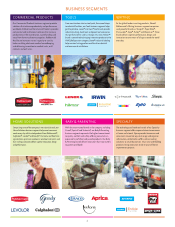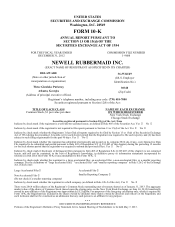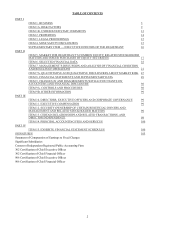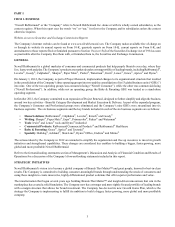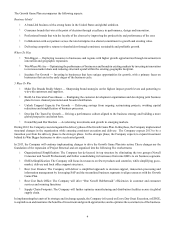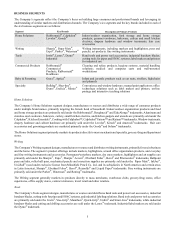Graco 2012 Annual Report Download - page 16
Download and view the complete annual report
Please find page 16 of the 2012 Graco annual report below. You can navigate through the pages in the report by either clicking on the pages listed below, or by using the keyword search tool below to find specific information within the annual report.10
The Company's plans to continue to improve productivity and reduce complexity and costs may not be successful, which
would adversely affect its ability to compete.
The Company's success depends on its ability to continuously improve its manufacturing operations to gain efficiencies, reduce
supply chain costs and streamline or redeploy nonstrategic selling, general and administrative expenses in order to produce products
at a best-cost position and allow the Company to invest in innovation and brand building. In October 2011, the Company announced
Project Renewal, a global initiative designed to reduce the complexity of the organization and increase investment in the Company's
most significant growth platforms, and in October 2012, the Company announced an expansion of Project Renewal, designed to
further simplify and align the business around two key activities — Brand & Category Development and Market Execution &
Delivery. As part of the expanded program, the Company's Consumer and Professional groups were eliminated and the Company's
nine global business units were streamlined into six business segments. In June 2010, the Company announced its European
Transformation Plan, a program to centralize its European business and leverage the benefits of scale and to facilitate a more
efficient and cost-effective implementation of an enterprise resource planning program. The Company runs the risk that these and
similar initiatives may not be completed substantially as planned, may be more costly to implement than expected, or may not
have the positive effects anticipated. In addition, these various initiatives require the Company to implement a significant amount
of organizational change which could divert management’s attention from other concerns, and if not properly managed, could
cause disruptions in the Company’s day-to-day operations and have a negative impact on the Company’s financial results. It is
also possible that other major productivity and streamlining programs may be required in the future.
If the Company is unable to commercialize a continuing stream of new products that create demand, the Company's ability
to compete in the marketplace may be adversely impacted.
The Company's long-term success in the competitive retail environment and the industrial and commercial markets depends on
its ability to develop and commercialize a continuing stream of innovative new products that create demand. The Company also
faces the risk that its competitors will introduce innovative new products that compete with the Company's products. The Company's
strategy includes investment in new product development and a focus on innovation. There are, nevertheless, numerous uncertainties
inherent in successfully developing and commercializing innovative new products on a continuing basis, and new product launches
may not deliver expected growth in sales or operating income.
If the Company does not continue to develop and maintain consumer-meaningful brands, its operating results may suffer.
The Company's ability to compete successfully also depends increasingly on its ability to develop and maintain consumer-
meaningful brands so that the Company's retailer and other customers will need the Company's products to meet consumer demand.
Consumer-meaningful brands allow the Company to realize economies of scale in its operations. The development and maintenance
of such brands require significant investment in brand-building and marketing initiatives. While the Company plans to continue
to increase its expenditures for advertising and other brand-building and marketing initiatives over the long term, the increased
investment may not deliver the anticipated results.
Price increases in raw materials and sourced products could harm the Company's financial results.
The Company purchases raw materials, including resin, principally polyethylene and polypropylene, corrugate, steel, gold, zinc,
brass and aluminum, which are subject to price volatility and inflationary pressures. The Company attempts to reduce its exposure
to increases in those costs through a variety of programs, including periodic purchases, future delivery purchases, long-term
contracts and sales price adjustments. Where practical, the Company uses derivatives as part of its risk management process. Also,
the Company relies on third-party manufacturers as a source for its products. These manufacturers are also subject to price volatility
and labor cost and other inflationary pressures, which may, in turn, result in an increase in the amount the Company pays for
sourced products. Raw material and sourced product price increases may more than offset the Company's productivity gains and
price increases and adversely impact the Company's financial results.
If the Company is unable to make strategic acquisitions and to integrate its acquired businesses, the Company's future
growth could be adversely impacted.
Although the Company is increasingly emphasizing internal growth rather than growth by acquisition, the Company's ability to
continue to make strategic acquisitions and to integrate the acquired businesses successfully, including obtaining anticipated cost
savings and operating income improvements within a reasonable period of time, remain important factors in the Company's future
growth. Furthermore, the Company's ability to finance major acquisitions may be adversely affected by the Company's financial
position and access to credit markets. In addition, significant additional borrowings would increase the Company's borrowing
costs and could adversely affect its credit rating and could constrain the Company's future access to capital.


